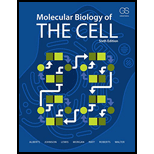
Concept explainers
44322-14-1P
To examine: Whether the statement, “The three respiratory enzyme complexes in the mitochondrial inner membrane tend to associate with each other in ways that facilitate the correct transfer of electrons between appropriate complexes.”, is true or false.
Introduction: The respiratory chain in the inner mitochondrial membrane contains three respiratory enzyme complexes, across which electrons proceed on their way from NADH to O2. In these complexes, electrons are transferred along with a series of protein-bound electron carriers. As the electrons travel toward lower-energy levels, it releases energy, and that energy is used to pump protons by various mechanisms in the three respiratory enzyme complexes.
Answer to Problem 1P
Correct answer: The statement is true.
Explanation of Solution
In mitochondria, the electron transfer process starts when two electrons and one proton are separated from NADH to generate NAD+ molecules. These electrons are passed to the first of about 20 different electron carries in the respiratory chain. Each respiratory enzyme complex is composed of protein subunits that are placed in the inner mitochondrial membrane. Every complex in the chain has a higher affinity for electrons than its predecessors. Electrons also pass sequentially from one complex to another complex until they finally move to the molecular oxygen.
As the high-energy electron travels from lower redox potential electron carrier to the high redox potential, energy is liberated in the form of ATP. Hence, electron flows across a series of electron carriers to release energy in a series. Stepwise release of energy is important because energy would be lost as heat in case of sudden energy release. Thus, for the efficient utilization of the released energy from the electron, it is important that the respiratory complexes are organized in a structurally ordered manner in the mitochondrial membrane.
Hence, the statement is true.
Want to see more full solutions like this?
Chapter 14 Solutions
Molecular Biology of the Cell (Sixth Edition)
 Human Anatomy & Physiology (11th Edition)BiologyISBN:9780134580999Author:Elaine N. Marieb, Katja N. HoehnPublisher:PEARSON
Human Anatomy & Physiology (11th Edition)BiologyISBN:9780134580999Author:Elaine N. Marieb, Katja N. HoehnPublisher:PEARSON Biology 2eBiologyISBN:9781947172517Author:Matthew Douglas, Jung Choi, Mary Ann ClarkPublisher:OpenStax
Biology 2eBiologyISBN:9781947172517Author:Matthew Douglas, Jung Choi, Mary Ann ClarkPublisher:OpenStax Anatomy & PhysiologyBiologyISBN:9781259398629Author:McKinley, Michael P., O'loughlin, Valerie Dean, Bidle, Theresa StouterPublisher:Mcgraw Hill Education,
Anatomy & PhysiologyBiologyISBN:9781259398629Author:McKinley, Michael P., O'loughlin, Valerie Dean, Bidle, Theresa StouterPublisher:Mcgraw Hill Education, Molecular Biology of the Cell (Sixth Edition)BiologyISBN:9780815344322Author:Bruce Alberts, Alexander D. Johnson, Julian Lewis, David Morgan, Martin Raff, Keith Roberts, Peter WalterPublisher:W. W. Norton & Company
Molecular Biology of the Cell (Sixth Edition)BiologyISBN:9780815344322Author:Bruce Alberts, Alexander D. Johnson, Julian Lewis, David Morgan, Martin Raff, Keith Roberts, Peter WalterPublisher:W. W. Norton & Company Laboratory Manual For Human Anatomy & PhysiologyBiologyISBN:9781260159363Author:Martin, Terry R., Prentice-craver, CynthiaPublisher:McGraw-Hill Publishing Co.
Laboratory Manual For Human Anatomy & PhysiologyBiologyISBN:9781260159363Author:Martin, Terry R., Prentice-craver, CynthiaPublisher:McGraw-Hill Publishing Co. Inquiry Into Life (16th Edition)BiologyISBN:9781260231700Author:Sylvia S. Mader, Michael WindelspechtPublisher:McGraw Hill Education
Inquiry Into Life (16th Edition)BiologyISBN:9781260231700Author:Sylvia S. Mader, Michael WindelspechtPublisher:McGraw Hill Education





